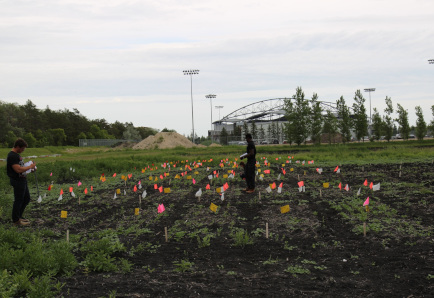
Photo Credit: John Gavloski, Manitoba Agriculture, Food and Rural Development
Project 1: Defoliation thresholds for modern high-yielding canola varieties across the Canadian prairies
Flea beetles are chronic pests on canola and result in yield losses estimated in CAN $300 million each year. Three species are responsible for most of the damage: the exotics Phyllotreta cruciferae (Goeze) and P. striolata (Fab.), and the native Psylliodes punctulata Melsh. Severe economic damage typically occurs in the spring through defoliation of canola seedlings by adults emerging from overwintering. Currently, the most widespread technique to control flea beetles in North America is the use of preventive insecticide treatments in canola seeds followed by foliar sprays if damage is still prevalent, resulting in more than 90% of the crop receiving pesticide applications for these pests. In collaboration with H. Cárcamo (AAFC Lethbridge, AB), J. Otani (AAFC Beaverlodge, AB), T. Wist (AAFC Saskatoon, SK), and J. Gavloski (MAFRD Carman, MB), we are conducting field studies in four ecoregions across the Canadian prairies to develop defoliation thresholds for modern high-yielding canola varieties.
Hypotheses
- Effectively managing flea beetle damage in modern high-yielding canola varieties with foliar sprays.
- Modern high-yielding canola varieties can tolerate higher defoliation levels than the current nominal threshold levels.
Project 2: Identifying natural enemies of flea beetles
Generalist predators have a very important role suppressing pests in several field crops. However, very little is known about predators attacking flea beetles in canola. The main objective of this project is to identify the suite of natural enemies of flea beetles in canola using innovative molecular methods. In collaboration with Dr. Barb Sharanowski (University of Central Florida), we are developing molecular primers to determine flea beetle predators through gut-content analysis.
Hypothesis
- Several species of generalist predators are consuming flea beetle larvae and adults in canola
Project 3: Defining landscape characteristics limiting flea beetle levels and increasing mortality
Flea beetles occur in unpredictable numbers and locations every year in the Canadian prairies. The main goal of this project is to define landscape characteristics that limit flea beetle populations and increase mortality of flea beetles by natural enemies in canola. In addition, in collaboration with WIN Enterprises we are collecting data on abiotic factors to develop prediction models of flea beetle abundance that will help guide management decisions.
Hypotheses
- Flea beetle abundance and outbreak levels in canola are decreased due to increased landscape complexity.
- Increased landscape complexity increase the abundance of generalist predators in canola.
- Populations models based on abiotic environmental conditions (e.g. temperature, precipitation, wind, soil temperature) can be used to predict flea beetle emergence and major seasonal activity.


